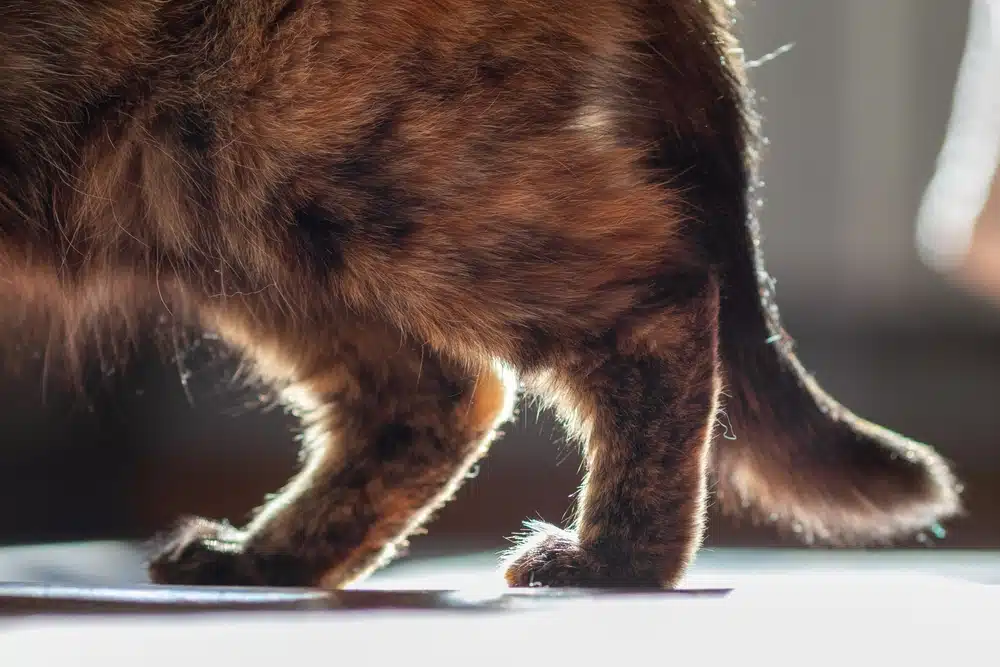Osteoarthritis (OA) is a degenerative joint disease that commonly affects pets, but pet owners don’t always recognize the signs. OA is the leading cause of chronic pain in pets, and our Animal Hospital of Parkland team wants to help by providing information about this painful disease and explaining how the condition can be managed.
Pet arthritis
OA is the most common form of arthritis affecting pets, and the disease affects the entire joint, sparing no tissue. The typical disease progression involves:
- Cartilage damage — In the earliest stages, the cartilage within the joint develops irregularities and focal erosions.
- Osteophytes — Cartilage damage leads to changes in the cellular structure, causing cartilage outgrowths that solidify to form bony protrusions called osteophytes.
- Joint capsule thickening — As the disease progresses, fibrosis occurs around and within the joint, leading to pain and impared function.
Pet arthritis causes
Mechanical stress, abnormal joint mechanics, and certain risk factors contribute to OA. While older pets are at higher risk for OA, old age is not a cause of OA. Factors that contribute to OA include:
- Body condition — Overweight pets are at higher risk for OA because the excess weight places added strain on their joints, and adipose tissue produces chronic, low grade inflammation that exacerbates the problem.
- Abnormal joint development — Pets affected by developmental orthopedic diseases, such as hip dysplasia, elbow dysplasia, and luxating patellas, are at increased risk.
- Injury history — Pets who have experienced a fracture, ligament or tendon damage, muscle injury, or joint infection are at higher risk for OA.
- Nutrition — Pets who are fed inappropriate diets can be predisposed to OA.
Pet arthritis signs
OA signs can be subtle, especially in the initial stages. The most common signs you may notice if your pet is affected include:
- Stiffness — Your pet may move stiffly, especially after lying down for an extended period.
- Difficulty rising — Your pet may have difficulty getting up after sitting or lying down for an extended period.
- Lameness — Your pet may favor one or more limbs.
- Gait changes — You may notice your pet moving in an abnormal way. For example, your dog may develop a bunny-hopping gait if they have hip OA.
- Avoiding interaction — Your typically active pet may lose interest in playing, or they may hide more frequently.
- Difficulty navigating stairs — Your pet may have difficulty going up or down stairs.
- Difficulty jumping — Your pet may have difficulty jumping on or off furniture and in and out of vehicles.
- Behavioral changes — Your pet may exhibit uncharacteristic grumpiness or aggression.
Pet arthritis diagnosis
OA diagnosis typically involves taking a thorough history, performing a physical examination, and imaging the affected joint. Specifics include:
- History — You know your pet better than anyone and are in the best position to notice signs that may indicate arthritis. Your veterinary team will ask questions to determine how your pet behaves while at home and if their activity level has changed.
- Physical examination — Your veterinary team will evaluate your pet’s gait to look for lameness or stiffness. They also will palpate and manipulate your pet’s joints to assess for pain, joint capsule thickening, joint swelling, and muscle atrophy.
- X-rays — X-rays can help determine how severely a joint is affected.
- Blood work — Your veterinary team may recommend a complete blood count (CBC) and biochemistry profile to assess your pet’s overall health before prescribing medications to help manage OA.
Pet arthritis treatment
OA treatment typically involves a multi-modal approach, and strategies are based on a pet’s condition and situation. Potential treatments include:
- Weight management — If your pet is overweight, your veterinary team will devise an appropriate weight loss strategy to help them safely lose the excess weight and decrease strain on their joints.
- Activity modification — Consistent low-impact controlled exercise is beneficial to help improve muscle strength around the joints and promote joint function, but high-impact activities, such as running or jumping, should be limited since they can cause more inflammation and pain.
- Pain control — Non-steroidal anti-inflammatories (NAIDs) are commonly prescribed to manage OA, and a new monoclonal antibody drug was approved in January to treat OA in cats. Your veterinary team can determine the best medications to manage your pet’s OA pain. Ensure you never use your own pain medications to treat your pet since these can be toxic to pets.
- Physical therapy — Range of motion exercises, therapeutic exercises, and water therapy can help increase joint mobility, improve muscle mass, and improve exercise endurance.
- Joint supplements — Supplements, such as chondroitin sulfate, glucosamine sulfate, and omega-3 fatty acids, may help pets affected by OA.
- Disease modulating agents — Injections administered in the muscle or in the joint may help alleviate OA signs.
- Surgery — In some cases, surgery is necessary to remove painful joint components and help stabilize the joint.
- Home modifications — You can take steps to modify your home to make your pet more comfortable, such as:
-
- Providing soft, well padded bedding
- Raising food and water dishes
- Providing ramps or steps to help your pet access high surfaces
- Placing non-skid floor surfaces
- Administering medications as prescribed
OA can significantly affect your pet’s quality of life, but you can take steps to manage their condition and alleviate their pain. If you think your pet is affected by OA, contact the Animal Hospital of Parkland team so we can assess their condition and devise an appropriate treatment strategy.


